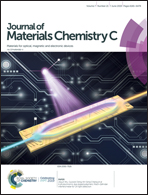Luminescence modulation of carbon dots assemblies†
Abstract
Integrating multi-emissive color in one platform provides a possible way to avoid background interference or to obtain white light. Thus, different luminescent units, including quantum dots, dyes, and rare-earth ions, are generally mixed, composited or embedded in a single matrix. However, this is a very cumbersome process. In the present work, double- and triple-emissive carbon dots (Cdots) assemblies were constructed using cost-effective, easy-accessible blue-emission Cdots as a precursor. The Cdots assemblies built by the crosslinking reactions between the amine groups of triethylenetetramine (TETA)-passivating Cdots and the aldehyde groups of glutaraldehyde (GA), showed photoluminescence (PL) peaks at 460, 559 and 656 nm. Furthermore, the assemblies formed from Cdots passivated with 1,8-diamine-3,6-dioxaoctane (DADO) exhibited double PL. Structural characterization and selective probe reactions showed that the multi-color emissions of Cdots assemblies should be from new fluorophore centers consisting of abundant imine bonds in a condensed microenvironment. When using the ink of TETA-Cdots assemblies to write alphabet letters, upon irradiation with different light, they showed abundant and variable colors, showing their potential application in anti-counterfeiting devices and white light-emitting diodes. This work provides a novel design, as well as a simple and practical technology, to obtain multi-color luminescent materials, and to tune the emission of Cdots.



 Please wait while we load your content...
Please wait while we load your content...